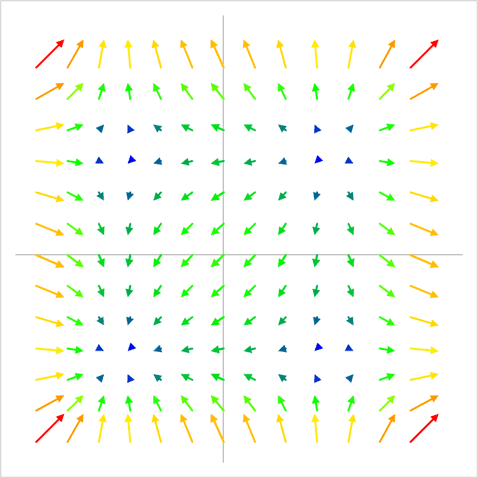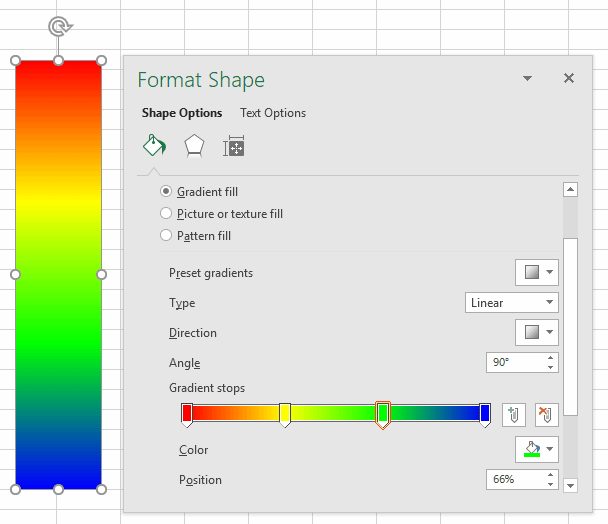In the last blog post, I showed how to use VBA to create a vector plot in Excel. That plot was just a simple black and white vector plot. So in this post I’ll show you how to take that chart to the next level with a color scale to indicate the magnitude of the vectors, like the one below:

The basic concept for creating the colored vector plot was this:
- Define a gradient which will be used to color the vectors.
- Determine the magnitude of each of the vectors
- Find the minimum and maximum magnitudes
- Calculate the relative percent magnitude of each vector (minimum = 0%, maximum = 100%)
- Interpolate on the gradient to find the percentage of red, green, and blue for the vector
- Plot the vector on the chart
- Apply the formatting to the vector, including the color
As you probably guessed, all of these steps (except for 1) were carried out in VBA. I’ll go through each one below
Defining the Gradient

Elevate Your Engineering With Excel
Advance in Excel with engineering-focused training that equips you with the skills to streamline projects and accelerate your career.
Excel makes it easy to play with gradients and find the one you like. I just created a rectangle on the worksheet, then filled it with a custom gradient with stops at 0%(red), 33% (yellow), 66% (green), and 100% (blue).

Next, I converted that into a table of RGB values vs. percent. I wanted 0% (or the smallest values) to be blue, and 100% (or the largest values) to be red. RGB values are integers between 0 and 255.

Later, I interpolated in VBA based on the relative magnitude of the vector (from 0-100%), so I also named each column (“legendx”, “legendr”, “legendg”, “legendb”) to make that interpolation easier.
With the gradient defined, let’s get into the VBA:
Calculating Vector Magnitudes, Minimum, Maximum in VBA
After defining the total number of vectors (numvect) and initializing the variables, “minvmag” and “maxvmag”, the code below loops through the rows of data to calculate each vector’s magnitude, “vmag”. It also stores each of the magnitudes in an array. This array will be used later when we color the vector with the appropriate color based on the gradient we defined.
Finally, the current value of vmag is compared to both maxvmag and minvmag. If it’s greater than maxvmag, the value of maxvmag is updated. If it’s less than minvmag, the value of minvmag is updated.
numvect = 196
minvmag = 1000000
maxvmag = 0
ReDim vmagarray(1 To numvect)
For j = 1 To numvect
x1 = Cells(4 + j, 2)
x2 = Cells(4 + j, 3)
y1 = Cells(4 + j, 5)
y2 = Cells(4 + j, 6)
vmag = Sqr((x1 - x2) ^ 2 + (y1 - y2) ^ 2)
vmagarray(j) = vmag
If vmag > maxvmag Then
maxvmag = vmag
ElseIf vmag < minvmag Then
minvmag = vmag
End If
Next j
Calculate the Relative Percent Magnitude of Each Vector
With the magnitudes of each vector as well as the minimum and maximum defined, I could move on to plotting each vector with a For loop (For i = 1 to numvect). Within the loop I had to normalize the vectors between 0 and 1, so that I could apply the gradient defined above. The equation below takes care of that:
relvmag = (vmagarray(i) - minvmag) / (maxvmag - minvmag)Interpolating to Get the Color for Each Vector
The relative vector magnitude could be any value between 0 and 1, so I needed to interpolate from the table above to find the correct color to apply to the vector. I used a simple linear interpolation function (LinInterp) I created previously to handle this.
And because RGB values are integers, I had to round the interpolation result to get the final value.
red = Round(LinInterp(relvmag, Range("legendx"), Range("legendr")))
grn = Round(LinInterp(relvmag, Range("legendx"), Range("legendg")))
blu = Round(LinInterp(relvmag, Range("legendx"), Range("legendb")))Plotting the Vector
The VBA to plot the vector as a series and format it as an arrow is the same as before:
xvalues = "=Sheet1!$B$" & i + 4 & ":$C$" & i + 4
yvalues = "=Sheet1!$E$" & i + 4 & ":$F$" & i + 4
'add the series to the chart
ActiveChart.SeriesCollection.NewSeries
ActiveChart.FullSeriesCollection(i).xvalues = xvalues
ActiveChart.FullSeriesCollection(i).Values = yvalues
With Selection.Format.Line
.EndArrowheadLength = msoArrowheadLengthMedium
.EndArrowheadWidth = msoArrowheadWidthMedium
.EndArrowheadStyle = msoArrowheadTriangleApplying a Color to the Vector
Finally, I used the interpolated RGB values (variables “red”, “grn”, “blu”) in the With loop to color the vectors:
.ForeColor.RGB = RGB(red, grn, blu)The Full VBA Subroutine for Creating a Colored Vector Plot
The entire subroutine for creating the colored vector plot in Excel is shown below:
Sub add_vector()
Dim xvalues As String
Dim yvalues As String
Dim numvect As Integer
Dim vmagarray() As Double
Dim minvmag As Double
Dim maxvmag As Double
Dim red As Integer
Dim grn As Integer
Dim blu As Integer
numvect = 196
'find the minimum and maximum vector magnitudes
'(these need to be defined before plotting)
'store the vector magnitudes in an array for later use
minvmag = 1000000
maxvmag = 0
ReDim vmagarray(1 To numvect)
For j = 1 To numvect
x1 = Cells(4 + j, 2)
x2 = Cells(4 + j, 3)
y1 = Cells(4 + j, 5)
y2 = Cells(4 + j, 6)
vmag = Sqr((x1 - x2) ^ 2 + (y1 - y2) ^ 2)
vmagarray(j) = vmag
If vmag > maxvmag Then
maxvmag = vmag
ElseIf vmag < minvmag Then
minvmag = vmag
End If
Next j
'activate the chart and select the plot area
ActiveSheet.ChartObjects("Chart 7").Activate
ActiveChart.PlotArea.Select
For i = 1 To numvect
'determine the relative percent magnitude of the vector
'(w.r.t. the minimum and maximum vectors)
relvmag = (vmagarray(i) - minvmag) / (maxvmag - minvmag)
'interpolate to find the % of red, green, and blue
red = Round(LinInterp(relvmag, Range("legendx"), Range("legendr")))
grn = Round(LinInterp(relvmag, Range("legendx"), Range("legendg")))
blu = Round(LinInterp(relvmag, Range("legendx"), Range("legendb")))
'define the xvalues and yvalues for the chart
xvalues = "=Sheet1!$B$" & i + 4 & ":$C$" & i + 4
yvalues = "=Sheet1!$E$" & i + 4 & ":$F$" & i + 4
'add the series to the chart
ActiveChart.SeriesCollection.NewSeries
ActiveChart.FullSeriesCollection(i).xvalues = xvalues
ActiveChart.FullSeriesCollection(i).Values = yvalues
ActiveChart.FullSeriesCollection(i).Select
'apply formatting to the series
With Selection.Format.Line
.EndArrowheadLength = msoArrowheadLengthMedium
.EndArrowheadWidth = msoArrowheadWidthMedium
.EndArrowheadStyle = msoArrowheadTriangle
.ForeColor.RGB = RGB(red, grn, blu)
End With
ActiveChart.ChartType = xlXYScatterLinesNoMarkers
Next i
End SubConclusion
Creating a colored vector plot in Excel is a little complex, but it’s always fun to see how we can stretch Excel’s limits to do something new!
